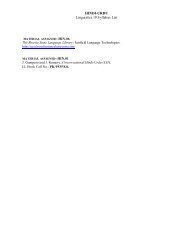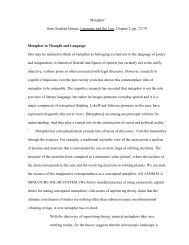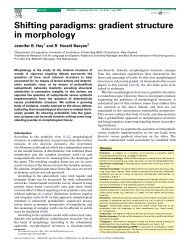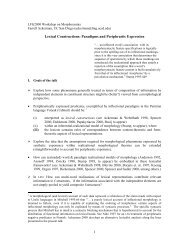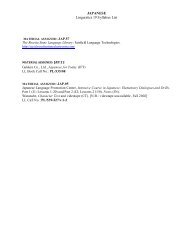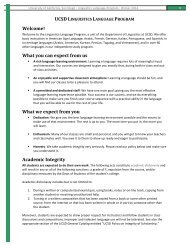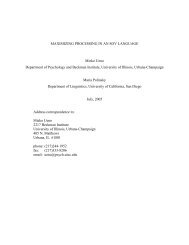42 Ryan K. Shosted & Sharon RoseTo the UPSID-PC list, one might add the following:Adyghe, Bagwali (or Bagwalal), and Karata (Caucasian) – Catford 1992Hausa 2 (Chadic) – Ladefoged & Maddieson 1996, Newman 2000, although see Lindsey,Hayward & Haruna 1992Mehri, Harsusi, Bathari, Hobyot, Jibbali (or Shehri) (SouthArabian) – Simeone-Senelle1997Upper Necaxa Totonac (Totonac-Tepehua) – Beck 2006Yapese (Oceanic) – Jensen 1977, Maddieson 1998Amharic (Ethio-Semitic) – Leslau 1995Tigre (Ethio-Semitic) – Palmer 1962, Raz 1983<strong>Tigrinya</strong> (Ethio-Semitic) – Leslau 1939, 1941This additional list is based on a general survey <strong>of</strong> the literature on <strong>ejective</strong> <strong>fricatives</strong>, not onan exhaustive survey <strong>of</strong> language grammars.<strong>The</strong> presence <strong>of</strong> an <strong>ejective</strong> fricative in a language seems almost always to imply thepresence <strong>of</strong> at least one other <strong>ejective</strong> obstruent. In all UPSID-PC languages the presence <strong>of</strong>an <strong>ejective</strong> fricative implies the presence <strong>of</strong> at least one <strong>ejective</strong> stop. One exception to thisgeneralization is Upper Necaxa Totonac (Beck 2006; not reported in UPSID-PC), which has<strong>ejective</strong> <strong>fricatives</strong> but no <strong>ejective</strong> stops or <strong>ejective</strong> affricates. Like languages with <strong>ejective</strong><strong>fricatives</strong>, UPSID-PC languages with <strong>ejective</strong> affricates fit neatly within the set <strong>of</strong> languageswith <strong>ejective</strong> stops. <strong>The</strong> only exception is Iraqw, a Cushitic language <strong>of</strong> Tanzania whichhas two <strong>ejective</strong> affricates but no <strong>ejective</strong> stop (nor an <strong>ejective</strong> fricative) (Whiteley 1958,see also Mous 1993). 3 Of the ten UPSID-PC languages with <strong>ejective</strong> <strong>fricatives</strong>, only threelack <strong>ejective</strong> affricates: Berta, Koma, and Soqotri. Conversely, <strong>of</strong> the 59 languages that have<strong>ejective</strong> affricates, only seven have <strong>ejective</strong> <strong>fricatives</strong> (see Figure 1). Thus, the chance <strong>of</strong> alanguage having <strong>ejective</strong> <strong>fricatives</strong> seems to increase slightly if the language also has <strong>ejective</strong>affricates. Of the seven languages that have both <strong>ejective</strong> <strong>fricatives</strong> and affricates, six (Acoma,Dakota, Mazahua, Tlingit, Wichita, and Yuchi) have affricates and <strong>ejective</strong>s at the same place<strong>of</strong> articulation.Ejectives are produced by trapping air between the tightly adducted vocal folds and aconstriction at an oral place <strong>of</strong> articulation. To produce an <strong>ejective</strong>, the larynx should beraised, thereby compressing the air in the supralaryngeal cavity (Ladefoged 1993: 130).Upon release, ‘the entrapped high-pressure air will momentarily burst forth in a short sharpexplosion’ (Catford 2001: 22).<strong>The</strong> release <strong>of</strong> the oral closure results in a sudden outflow <strong>of</strong> air (a glottalic egressiveairstream), along with a characteristic burst <strong>of</strong> acoustic energy. After this, the laryngeal closureis released, the suprahyoid musculature relaxes, thus lowering the larynx, and pulmonicegressive airflow may course through the glottis.<strong>The</strong> production <strong>of</strong> an <strong>ejective</strong> fricative involves an aeroacoustic dilemma. Two competingdemands, stated here as directives, must be satisfied: (i) Ejectivity: Substantially increaseair pressure above the larynx (to a degree greater than expected during pulmonicegressive obstruents); (ii) Frication: Vent air continuously through a narrow constriction.<strong>The</strong> venting required <strong>of</strong> a fricative may defeat the increase in pressure required <strong>of</strong> an<strong>ejective</strong>.Maddieson (1997, 1998) has put forward two mechanisms for satisfying these demands.First, he proposes reducing the size <strong>of</strong> the constriction between oral articulators to increase2 Maddieson & Precoda (1991) characterize the Hausa fricative as ‘laryngealized’ and place it, byimplication, in the same category as <strong>fricatives</strong> in Korean, Siona, Southern Nambiquara, Sui, andWapishana.3 Mous (1993:17) describes the uvular transcribed [q] as an affricate, which is, however, realized as a stopin pre-consonantal position, and optionally as an <strong>ejective</strong> stop word-initially.
<strong>Affricating</strong> <strong>ejective</strong> <strong>fricatives</strong>: <strong>The</strong> <strong>case</strong> <strong>of</strong> <strong>Tigrinya</strong> 43N = 3N = 6N = 7Stops OnlyStops + FricativesStops + AffricatesStops, Fricatives + AffricatesN = 52Figure 1 Languages with <strong>ejective</strong> stops in UPSID-PC (Maddieson & Precoda 1991) categorized by the presence/absence <strong>of</strong> <strong>ejective</strong><strong>fricatives</strong> and/or affricates.intraoral pressure. Thus, the fricative can be produced exclusively on the outflow <strong>of</strong> air trappedabove the larynx, albeit at some cost to net flow and therefore duration. <strong>The</strong> <strong>ejective</strong> <strong>fricatives</strong><strong>of</strong> Tlingit, with an oral constriction narrower than that <strong>of</strong> pulmonic <strong>fricatives</strong>, are <strong>of</strong> this type.<strong>The</strong>y allow intraoral air pressure to achieve a higher peak than is found during pulmonic<strong>fricatives</strong> but the duration is reduced, since the supralaryngeal cavity volume is much smallerthan the volume <strong>of</strong> the lungs (Maddieson, Smith & Bessell 2001).Maddieson’s (1997, 1998) second proposal for resolving the aeroacoustic dilemma is tosequence frication and glottal constriction, as in Yapese. This proposal raises the question <strong>of</strong>whether such a sound still qualifies as an <strong>ejective</strong> in the classic sense, e.g. that <strong>of</strong> Catford(2001). After all, frication is not produced simultaneously with glottal closure, nor is thelarynx necessarily raised to increase pressure during the fricative. Indeed, Maddieson (1998)concludes that Yapese <strong>ejective</strong> <strong>fricatives</strong> are not <strong>ejective</strong>s at all, but a sequence <strong>of</strong> e.g. /f/+///(see Section 1.3.5 for further discussion <strong>of</strong> Yapese).Beyond these two mechanisms, another may be posited: Frication may be preceded bya period <strong>of</strong> oral closure, allowing time for air pressure to build (we will refer to this as theAFFRICATION HYPOTHESIS). Closure plus frication is characteristic <strong>of</strong> affricates, not <strong>fricatives</strong>,and thus raises the question <strong>of</strong> whether <strong>ejective</strong> <strong>fricatives</strong> realized in this way have crossedan ontological boundary. Pre-release closures have been reported in the literature for <strong>ejective</strong><strong>fricatives</strong> in Amharic (Demolin 2002) and Kabardian (Gordon & Applebaum 2006) with littlecomment.<strong>The</strong> purpose <strong>of</strong> this paper is to further elaborate the affrication hypothesis through anacoustic study <strong>of</strong> the alveolar <strong>ejective</strong> fricative in <strong>Tigrinya</strong>. <strong>The</strong> results will suggest thatthis fricative is <strong>of</strong>ten realized as an affricate, thus explaining historical confusion about thetranscription <strong>of</strong> the sound, as well as dialectal variation in its realization. More generally, theresults will suggest that affrication is a phonetically natural path in the evolution <strong>of</strong> <strong>ejective</strong><strong>fricatives</strong>.1.2 <strong>Tigrinya</strong> and its <strong>ejective</strong> <strong>fricatives</strong><strong>Tigrinya</strong> is a North Ethio-Semitic language spoken in northern Ethiopia and Eritrea. <strong>The</strong>Ethio-Semitic (also termed Ethiopian Semitic) family is classified as South Semitic, part <strong>of</strong>the larger West Semitic branch (Faber 2007). <strong>The</strong> consonant inventory for <strong>Tigrinya</strong> is shownin Table 1. <strong>The</strong>re are five <strong>ejective</strong>s: /t’ k’ k ’ s’ ’/,




